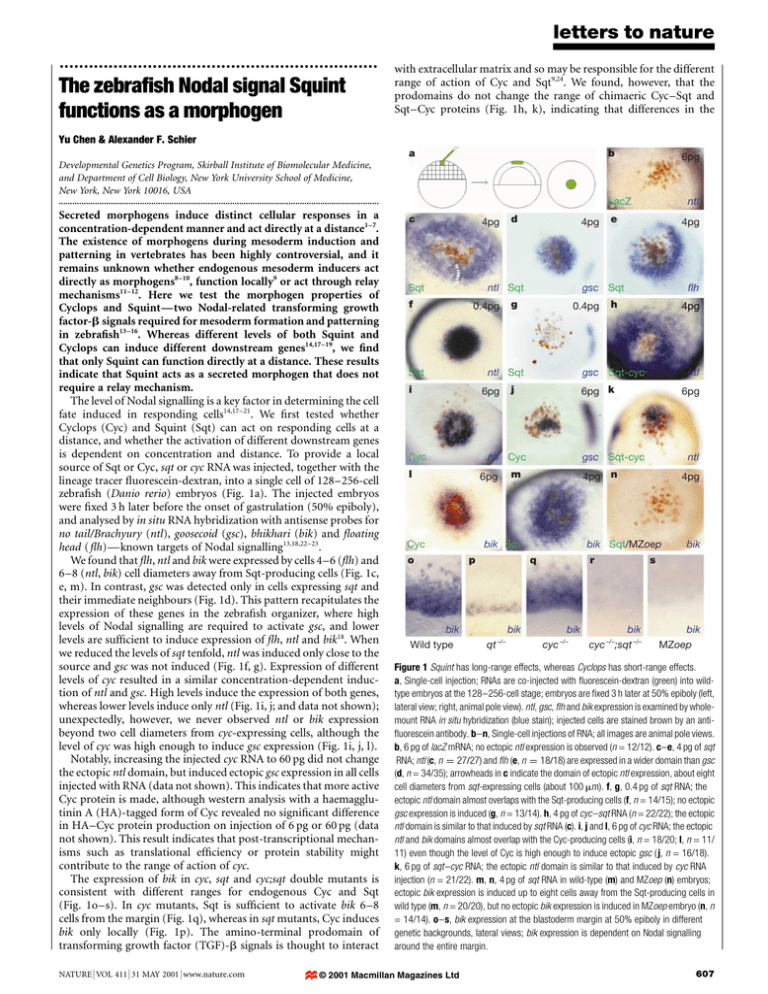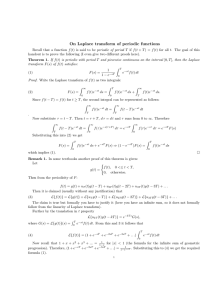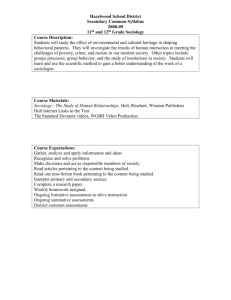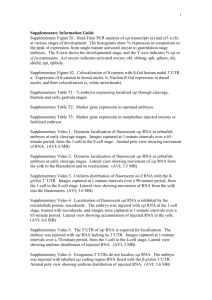................................................................. The zebra®sh Nodal signal Squint functions as a morphogen letters to nature
advertisement

letters to nature ................................................................. The zebra®sh Nodal signal Squint functions as a morphogen with extracellular matrix and so may be responsible for the different range of action of Cyc and Sqt9,24. We found, however, that the prodomains do not change the range of chimaeric Cyc±Sqt and Sqt±Cyc proteins (Fig. 1h, k), indicating that differences in the Yu Chen & Alexander F. Schier a b 6pg Developmental Genetics Program, Skirball Institute of Biomolecular Medicine, and Department of Cell Biology, New York University School of Medicine, New York, New York 10016, USA .............................................................................................................................................. Secreted morphogens induce distinct cellular responses in a concentration-dependent manner and act directly at a distance1±7. The existence of morphogens during mesoderm induction and patterning in vertebrates has been highly controversial, and it remains unknown whether endogenous mesoderm inducers act directly as morphogens8±10, function locally9 or act through relay mechanisms11±12. Here we test the morphogen properties of Cyclops and SquintÐtwo Nodal-related transforming growth factor-b signals required for mesoderm formation and patterning in zebra®sh13±16. Whereas different levels of both Squint and Cyclops can induce different downstream genes14,17±19, we ®nd that only Squint can function directly at a distance. These results indicate that Squint acts as a secreted morphogen that does not require a relay mechanism. The level of Nodal signalling is a key factor in determining the cell fate induced in responding cells14,17±21. We ®rst tested whether Cyclops (Cyc) and Squint (Sqt) can act on responding cells at a distance, and whether the activation of different downstream genes is dependent on concentration and distance. To provide a local source of Sqt or Cyc, sqt or cyc RNA was injected, together with the lineage tracer ¯uorescein-dextran, into a single cell of 128±256-cell zebra®sh (Danio rerio) embryos (Fig. 1a). The injected embryos were ®xed 3 h later before the onset of gastrulation (50% epiboly), and analysed by in situ RNA hybridization with antisense probes for no tail/Brachyury (ntl), goosecoid (gsc), bhikhari (bik) and ¯oating head ( ¯h)Ðknown targets of Nodal signalling13,18,22±23. We found that ¯h, ntl and bik were expressed by cells 4±6 (¯h) and 6±8 (ntl, bik) cell diameters away from Sqt-producing cells (Fig. 1c, e, m). In contrast, gsc was detected only in cells expressing sqt and their immediate neighbours (Fig. 1d). This pattern recapitulates the expression of these genes in the zebra®sh organizer, where high levels of Nodal signalling are required to activate gsc, and lower levels are suf®cient to induce expression of ¯h, ntl and bik18. When we reduced the levels of sqt tenfold, ntl was induced only close to the source and gsc was not induced (Fig. 1f, g). Expression of different levels of cyc resulted in a similar concentration-dependent induction of ntl and gsc. High levels induce the expression of both genes, whereas lower levels induce only ntl (Fig. 1i, j; and data not shown); unexpectedly, however, we never observed ntl or bik expression beyond two cell diameters from cyc-expressing cells, although the level of cyc was high enough to induce gsc expression (Fig. 1i, j, l). Notably, increasing the injected cyc RNA to 60 pg did not change the ectopic ntl domain, but induced ectopic gsc expression in all cells injected with RNA (data not shown). This indicates that more active Cyc protein is made, although western analysis with a haemagglutinin A (HA)-tagged form of Cyc revealed no signi®cant difference in HA±Cyc protein production on injection of 6 pg or 60 pg (data not shown). This result indicates that post-transcriptional mechanisms such as translational ef®ciency or protein stability might contribute to the range of action of cyc. The expression of bik in cyc, sqt and cyc;sqt double mutants is consistent with different ranges for endogenous Cyc and Sqt (Fig. 1o±s). In cyc mutants, Sqt is suf®cient to activate bik 6±8 cells from the margin (Fig. 1q), whereas in sqt mutants, Cyc induces bik only locally (Fig. 1p). The amino-terminal prodomain of transforming growth factor (TGF)-b signals is thought to interact NATURE | VOL 411 | 31 MAY 2001 | www.nature.com LacZ c 4pg Sqt f 0.4pg 6pg Cyc 0.4pg 6pg Cyc ntl 6pg ntl 4pg n 4pg bik Sqt/MZoep q bik 4pg gsc Sqt-cyc bik Sqt qt –/– flh h 6pg k m p 4pg gsc Sqt-cyc j ntl Cyc l ntl e gsc Sqt g ntl Sqt i bik Wild type 4pg ntl Sqt Sqt o d r bik bik cyc –/– cyc –/–;sqt –/– bik s bik MZoep Figure 1 Squint has long-range effects, whereas Cyclops has short-range effects. a, Single-cell injection; RNAs are co-injected with ¯uorescein-dextran (green) into wildtype embryos at the 128±256-cell stage; embryos are ®xed 3 h later at 50% epiboly (left, lateral view; right, animal pole view). ntl, gsc, ¯h and bik expression is examined by wholemount RNA in situ hybridization (blue stain); injected cells are stained brown by an anti¯uorescein antibody. b±n, Single-cell injections of RNA; all images are animal pole views. b, 6 pg of lacZ mRNA; no ectopic ntl expression is observed (n = 12/12). c±e, 4 pg of sqt RNA; ntl (c, n 27=27) and flh (e, n 18=18) are expressed in a wider domain than gsc (d, n = 34/35); arrowheads in c indicate the domain of ectopic ntl expression, about eight cell diameters from sqt-expressing cells (about 100 mm). f, g, 0.4 pg of sqt RNA; the ectopic ntl domain almost overlaps with the Sqt-producing cells (f, n = 14/15); no ectopic gsc expression is induced (g, n = 13/14). h, 4 pg of cyc±sqt RNA (n = 22/22); the ectopic ntl domain is similar to that induced by sqt RNA (c). i, j and l, 6 pg of cyc RNA; the ectopic ntl and bik domains almost overlap with the Cyc-producing cells (i, n = 18/20; l, n = 11/ 11) even though the level of Cyc is high enough to induce ectopic gsc ( j, n = 16/18). k, 6 pg of sqt±cyc RNA; the ectopic ntl domain is similar to that induced by cyc RNA injection (n = 21/22). m, n, 4 pg of sqt RNA in wild-type (m) and MZoep (n) embryos; ectopic bik expression is induced up to eight cells away from the Sqt-producing cells in wild type (m, n = 20/20), but no ectopic bik expression is induced in MZoep embryo (n, n = 14/14). o±s, bik expression at the blastoderm margin at 50% epiboly in different genetic backgrounds, lateral views; bik expression is dependent on Nodal signalling around the entire margin. © 2001 Macmillan Magazines Ltd 607 letters to nature a cyc;sqt MZoep Relay through Oepindependent signal MZoep Relay through Cyc or Sqt Relay through OepDirect dependent signal MZoep sqt + oep RNA ntI cyc;sqt MZoep sqt RNA ntl + lineage tracer Figure 2 Squint signals to distant cells either directly or through an Oep-dependent relay signal. a, Design and predictions for the experiment described in b±g. b±g, Single-cell injection into MZoep embryo of 4 pg of sqt RNA (b, c) or 4 pg of sqt RNA plus 4 pg of oep RNA (d±g). Note that MZoep mutants express ntl at the lateral and ventral margin, but not dorsally (b, c); b, d, f are in situ stainings of ntl expression (blue); c, e, g are double stainings of both ntl expression (blue) and lineage tracer detected with anti-¯uorescein antibody (brown). b, c, No ectopic ntl expression (blue) is detected owing to the inability of MZoep cells to respond to Sqt (n = 14/14). d±g, ntl is only expressed by cells injected with sqt and oep RNA (n = 19/19). Arrows of different colours indicate the corresponding cells in d and e, as well as in f and g; note that there are two cells marked by the green arrows in g that contain the lineage tracer but do not express ntl. mature region contribute to the different ranges of action. Together, these results indicate different effective ranges for Sqt and Cyc. Given the dynamic cell movements during early embryogenesis, the apparent long-range effect of Sqt might be a result of the displacement of cells that initiated expression of ntl because early on they were adjacent to sqt-expressing cells25. Although the shortrange effect of Cyc argues against this possibility, we tested it by transplanting labelled wild-type cells at a distance from the sqtexpressing cells. To make sure that these two cell populations never got within close proximity of each other, we monitored their relative positions after transplantation. We found that transplanted cells that maintained their distance from the Sqt source expressed ntl, as did their neighbouring host cells (Supplementary Information Fig. 1). Thus, cell movement does not cause the long-range effect of Sqt. Two models can explain the long-range effect of Sqt: Sqt might act as a morphogen and directly activate target gene expression at a distance; or Sqt might activate a relay signal, which then acts on distant cells. Both mechanisms have been invoked previously to account for the long-range effects of non-endogenous TGF-b signals8±12. To assay the range of Sqt's direct action, we made use of the observation that cells that lack the activity of the EGF-CFC protein One-eyed pinhead (Oep) cannot perceive Nodal signals22. Oep is an extracellular cofactor required cell-autonomously for the reception of Nodal signals22,26±28. 608 Direct cyc;sqt Relay through other Oep-dependent signal cyc;sqt ntl + linage tracer ntl b c Wild type cyc–/–;sqt–/– d e Wild type cyc–/–;sqt–/– Figure 3 The long-range effect of Sqt does not depend on the induction of the endogenous cyc or sqt genes. a, Design and predictions for the experiments shown in b±e. b±e, Single-cell injection of 4 pg of sqt RNA plus lineage tracers biotin-dextran and rhodamine-dextran into wild-type (b, d, n = 18/18) and cyc;sqt double mutant embryos (c, e, n = 12/12) at the 128±256-cell stage. b, c, Focus is on the expression domain of ntl in marginal cells; cyc;sqt double mutants were distinguished from sibling embryos (b) by the lack of ntl expression on the dorsal side (c). d, e, High-magni®cation views of the embryos in b and c; the lineage tracer biotin-dextran was detected with the ABC kit from Vectastain (red). Maternal-zygotic mutants for oep (MZoep embryos) have an identical phenotype to cyc;sqt double mutants and are unresponsive to Nodal signals22. These mutants are not impaired in signalling for ®broblast growth factor (FGF), bone morphogenetic protein (BMP) or Activin22, but none of the known Nodal-responsive genes (bik, ntl, gsc, ¯h, antivin, pitx2, cyc) can be activated by overexpression of Sqt in MZoep mutants, and ubiquitous or local expression of Sqt has no phenotypic effects in MZoep mutants22 (Figs 1n, 2c; and data not shown). Using these MZoep mutants, we tested whether Sqt acts directly at a distance or indirectly through a relay signal. We ®rst juxtaposed Sqt-responsive cells with Sqt non-responsive cells (oep mutant) to test whether an Oep-independent relay signal such as FGF12 is involved in the long-range effect of Sqt (Fig. 2). We injected both sqt and oep RNAs into a single cell of 128±256-cell MZoep embryos. oep RNA injection allows the injected cells to transduce the Sqt signal. If Sqt can induce a relay signal whose transduction is Oep independent and activates target genes such as ntl, then ntl would be expressed not only in the injected cells but also in the surrounding oep mutant cells (Fig. 2a). But if Sqt acts as a morphogen or relays through signals whose transduction is dependent on Oep, then ntl expression would be observed only in cells expressing Oep. Consistent with the second scheme, we found that only cells containing both Oep and Sqt expressed ntl (Fig. 2d±g). No non-autonomous induction of ntl was observed. To test whether the long-range effect of Sqt is a result of propagated induction of cyc or sqt, we analysed ntl expression induced by Sqt in cyc;sqt double-mutant embryos (Fig. 3a). We found that the domain of ntl expression induced in these embryos (Fig. 3c, e) is very similar to that in wild-type embryos (Fig. 3b, d), suggesting that the long-range effect of Sqt does not depend on the induction of the endogenous cyc or sqt genes. These results are consistent with the idea that Sqt acts as a morphogen, but it is also possible that Sqt may relay through an unknown signal whose transmission is Oep dependent (Fig. 4a). To address this possibility, we injected sqt RNA into a single cell of © 2001 Macmillan Magazines Ltd NATURE | VOL 411 | 31 MAY 2001 | www.nature.com letters to nature MZoep Relay MZoep sqt RNA Direct MZoep Wild-type cells ntl +1h +2h Figure 4 Squint signals directly to distant cells. a, Experimental design and predictions. b, Control; transplantation of wild-type cells (brown) into MZoep embryo, no ectopic ntl expression is observed (n = 14/14). Note that MZoep mutants express ntl at the lateral and ventral margin, but not dorsally. c±i, Single-cell injection of 4 pg of sqt RNA and ¯uorescein-dextran (green) into MZoep embryo, followed by transplanting wild-type donor cells labelled with biotin-dextran and rhodamine-dextran (red) at a distance to the sqt- injected cells (green) at the 1,000±2,000-cell stage; two examples (c±d and e±i) are shown. c, d, Note ectopic ntl staining (blue) at a distance from the sqt-expressing cells (brown) (n = 7/18). e±g, Images of the embryo in h and i after transplantation; e was taken shortly after transplantation; f and g were taken 1 h (f) and 2 h (g) after e. h, i, Transplanted cells (arrow in g) stained with ntl probe (arrow); i, High-magni®cation view of the ntl-expressing cells in h (n = 6/12). MZoep mutants and then transplanted several wild-type cells at a distance to the sqt-expressing cells. We also followed the movement of both sqt-expressing mutant cells and transplanted wild-type cells to ensure that they were not in close proximity between the time of transplantation and ®xation (Fig. 4e±g). Owing to the lack of Oep function in sqt-expressing and neighbouring cells, Sqt cannot activate the Nodal signalling pathway in these cells and thus no relay signal can be produced. If Sqt acts by a relay mechanism, the transplanted wild-type cells would not be able to express ntl. But if Sqt activates gene expression directly at a distance, wild-type cells should be able to receive the Sqt signal and express ntl. Consistent with the latter possibility, we found that wild-type cells in MZoep mutant embryos can express ntl in response to a distant source of Sqt. This result suggests that Sqt activity produced in unresponsive (oep mutant) cells can traverse a ®eld of unresponsive (oep mutant) cells to elicit an effect in distant responsive (wild-type) cells. These results show that the long-range effect of Sqt is direct, requiring no relay signal (Fig. 4c±i). The idea of locally secreted signals that act as morphogens and directly pattern a tissue by eliciting distant responses has been an attractive mechanism to explain many developmental events1±10. The potential of vertebrate mesoderm inducers to act as morphogens has been debated for a long time. Seemingly contradictory analyses of non-endogenous TGF-b signals have supported con¯icting models. Elegant studies in Xenopus explants have revealed the potential of Activin to act as a long-range morphogen8±10. In contrast, in vivo studies in zebra®sh have suggested that Activin acts only locally and induces FGF as a relay signal12. Similarly, Xnr2 and TGF-b1 have been suggested to act only at short range9,11. Our studies using the in vivo mesoderm inducers Cyc and Sqt now indicate that both short- and long-range mechanisms can operate during mesoderm induction and patterning. Notably, our results indicate that Sqt may act as a secreted morphogen: ®rst, different levels of Sqt induce different downstream responses in a concentration- and distance-dependent way14,17±19 (Fig. 1); second, Sqt can act directly at a distance (Figs 2±4). These results indicate that Squint acts as a secreted morphogen that does not require a relay mechanism. M Genotyping Methods Single-cell injection The lineage tracer ¯uorescein-dextran was co-injected with the RNA to mark the injected cell and its progeny. We synthesized sqt, cyc and oep sense, capped mRNAs as described18. RNA in situ hybridization and anti-¯uorescein antibody staining were performed as described22. NATURE | VOL 411 | 31 MAY 2001 | www.nature.com After photography, embryos were washed twice in benzyl benzoate : benzyl alcohol (2:1), two or three times in 100% methanol and once in 100% ethanol. We extracted genomic DNA using the DNeasy Tissue Kit (Qiagen). After extraction, genomic DNA was precipitated and resuspended in 50 ml H2O. Five microlitres of the genomic DNA was used as a template in each polymerase chain reaction (PCR). Primers and conditions for genotyping sqtcz35 and cycm294 have been described13. Chimaera construction Cyc±Sqt and Sqt±Cyc fusion proteins were constructed using PCR ampli®cation. The junction sequence of Cyc±Sqt is RRGRRNHRT, in which the underlined sequence is the C terminus of the Cyc prodomain and the rest is the N terminus of the Sqt mature peptide. The junction sequence for Sqt±Cyc is RRHRRGPPVRR, in which the underlined sequence is the N terminus of the Cyc mature peptide and the rest is the C terminus of the Sqt prodomain. Transplantation and triple labelling Donor embryos were injected with biotin-dextran and rhodamine-dextran at the 1±4-cell stage. We carried out transplantation as described22. After in situ hybridization and detection of ¯uorescein-dextran, the biotin-dextran labelled donor cells were detected with the alkaline phosphatase substrate kit 1 (Vector Laboratories, Inc.). Imaging Fluorescent and Nomarski images were taken after mounting the embryo in 2.5% methyl cellulose. Images were acquired as described18. Received 18 October 2000; accepted 26 February 2001 1. Turing, A. M. The chemical basis of morphogenesis. Phil. Trans. R. Soc. Lond. B. 237, 37±72 (1952). 2. Wolpert, L. Positional information and the spatial pattern of cellular differentiation. J. Theor. Biol. 25, 1±47 (1969). 3. Nellen, D., Burke, R., Struhl, G. & Basler, K. Direct and long-range action of a DPP morphogen gradient. Cell 85, 357±368 (1996). 4. Lecuit, T. et al. Two distinct mechanisms for long-range patterning by Decapentaplegic in the Drosophila wing. Nature 381, 387±393 (1996). 5. Zecca, M., Basler, K. & Struhl, G. Direct and long-range action of a wingless morphogen gradient. Cell 87, 833±844 (1996). 6. Neumann, C. J. & Cohen, S. M. Long-range action of Wingless organizes the dorsal±ventral axis of the Drosophila wing. Development 124, 871±880 (1997). 7. Neumann, C. & Cohen, S. Morphogens and pattern formation. BioEssays 19, 721±729 (1997). 8. Gurdon, J. B., Harger, P., Mitchell A. & Lemaire, P. Activin signalling and response to a morphogen gradient. Nature 371, 487±492 (1994). 9. Jones, C. M., Armes, N. & Smith, J. C. Signalling by TGF-b family members: short-range effects of Xnr-2 and BMP-4 contrast with the long-range effects of activin. Curr. Biol. 6, 1468±1475 (1996). 10. McDowell, N., Zorn, A. M., Crease, D. J. & Gurdon, J. B. Activin has direct long-range signalling activity and can form a concentration gradient by diffusion. Curr. Biol. 7, 671±681 (1997). 11. Reilly, K. M. & Melton, D. A. Short-range signaling by candidate morphogens of the TGF beta family and evidence for a relay mechanism of induction. Cell 86, 743±754 (1996). 12. Rodaway, A. et al. Induction of the mesendoderm in the zebra®sh germ ring by yolk cell-derived TGFb family signals and discrimination of mesoderm and endoderm by FGF. Development 126, 3067± 3078 (1999). 13. Feldman, B. et al. Zebra®sh organizer development and germ-layer formation require nodal-related signals. Nature 395, 181±185 (1998). 14. Sampath, K. et al. Induction of the zebra®sh ventral brain and ¯oorplate requires cyclops/nodal signalling. Nature 395, 185±189 (1998). © 2001 Macmillan Magazines Ltd 609 letters to nature 15. Rebagliati, M. R., Toyama, R., Haffter, P. & Dawid, I. B. cyclops encodes a nodal-related factor involved in midline signaling. Proc. Natl Acad. Sci. USA 95, 9932±7 (1998). 16. Schier, A. F. & Shen, M. M. Nodal signalling in vertebrate development. Nature 403, 385±389 (2000). 17. Erter, C. E., Solnica-Krezel, L. & Wright, C. V. Zebra®sh nodal-related 2 encodes an early mesendodermal inducer signaling from the extraembryonic yolk syncytial layer. Dev. Biol. 204, 361± 372 (1998). 18. Gritsman, K., Talbot, W. S. & Schier, A. F. Nodal signaling patterns the organizer. Development 127, 921±932 (2000). 19. Thisse, B., Wright, C. V. & Thisse, C. Activin- and Nodal-related factors control antero-posterior patterning of the zebra®sh embryo. Nature 403, 425±428 (2000). 20. Jones, C. M., Kuehn, M. R., Hogan, B. L., Smith, J. C. & Wright, C. V. Nodal-related signals induce axial mesoderm and dorsalize mesoderm during gastrulation. Development 121, 3651±3662 (1995). 21. Agius, E., Oelgeschlager, M., Wessely, O., Kemp, C. & De Robertis, E. M. Endodermal Nodal-related signals and mesoderm induction in Xenopus. Development 127, 1173±1183 (2000). 22. Gritsman, K. et al. The EGF-CFC protein one-eyed pinhead is essential for nodal signaling. Cell 97, 121±132 (1999). 23. Vogel, A. M. & Gerster, T. Promoter activity of the zebra®sh bhikhari retroelement requires an intact activin signaling pathway. Mech. Dev. 85, 133±146 (1999). 24. Ruppert, R., Hoffmann, E. & Sebald, W. Human bone morphogenetic protein 2 contains a heparinbinding site which modi®es its biological activity. Eur. J. Biochem. 237, 295±302 (1996). 25. Pfeiffer, S., Alexandre, C., Calleja, M. & Vincent, J. P. The progeny of wingless-expressing cells deliver the signal at a distance in Drosophila embryos. Curr. Biol. 10, 321±324 (2000). 26. Schier, A. F., Neuhauss, S. C., Helde, K, A., Talbot, W. S. & Driever, W. The one-eyed pinhead gene functions in mesoderm and endoderm formation in zebra®sh and interacts with no tail. Development 124, 327±342 (1997). 27. Zhang, J., Talbot, W. S. & Schier, A. F. Positional cloning identi®es zebra®sh one-eyed pinhead as a permissive EGF-related ligand required during gastrulation. Cell 92, 241±251 (1998). 28. StraÈhle, U. et al. one-eyed pinhead is required for development of the ventral midline of the zebra®sh (Danio rerio) neural tube. Genes Funct. 1, 131±148 (1997). Supplementary information is available on Nature's World-Wide Web site (http://www.nature.com) or as paper copy from the London editorial of®ce of Nature. mutant alleles of the MICROTUBULE ORGANIZATION 1 (MOR1) gene. Here we show that MOR1 is the plant version of an ancient family of microtubule-associated proteins4. Point mutations that substitute single amino-acid residues in an amino-terminal HEAT repeat impart reversible temperaturedependent cortical microtubule disruption, showing that MOR1 is essential for cortical microtubule organization. In most plant cells that display diffuse rather than tip growth, microtubules localize to the cortical cytoplasm perpendicular to the major axis of expansion. Microtubules and cellulose micro®brils often have similar orientation patterns in elongating cells5 and it is generally accepted, but not proven, that cortical microtubules control the alignment of cellulose micro®brils6. Identifying the factors that organize microtubule arrays at the periphery of plant cells is a necessary step towards understanding the mechanisms that underlie wall deposition and, hence, plant morphogenesis. To identify factors regulating cortical microtubule organization in plant cells, we used immuno¯uorescence microscopy to screen chemically mutagenized seedlings of A. thaliana for aberrant microtubule patterns. One mutant locus, mor1, causes temperature-sensitive cortical microtubule shortening and disorganization (Fig. 1) and consequent morphological defects. We used ecotypespeci®c markers to identify MOR1 as a gene of around 14 kilobases (kb) that encodes a protein with a predicted relative molecular mass of 217,000 (Mr 217K) (Fig. 2a) that has signi®cant deduced aminoacid sequence similarity to human TOGp7, Xenopus MAP215 Acknowledgements We thank members of the Schier and Yelon laboratories for discussions; R. Burdine, A. Carmany-Rampey, K. Joubin, R. Lehmann, G. Struhl, W. Talbot and D. Yelon for comments on the manuscript; S. Zimmerman, R. Feeney and T. Bruno for ®sh care. Y.C. is the Rebecca Ridley Kry Fellow of the Cancer Research Fund of the Damon Runyon±Walter Winchell Foundation. A.F.S. is a Scholar of the McKnight Endowment Fund for Neuroscience and the Irma T. Hirschl Trust, and is supported by grants from the NIH. Correspondence and requests for materials should be addressed to A.F.S. (e-mail: schier@saturn.med.nyu.edu). ................................................................. MOR1 is essential for organizing cortical microtubules in plants Angela T. Whittington, Oliver Vugrek, Ke Jun Wei, Nortrud G. Hasenbein, Keiko Sugimoto*, Madeleine C. Rashbrooke & Geoffrey O. Wasteneys Plant Cell Biology Group, Research School of Biological Sciences, The Australian National University, GPO Box 475, Canberra, ACT 2601, Australia .............................................................................................................................................. Microtubules orchestrate cell division and morphogenesis, but how they disassemble and reappear at different subcellular locations is unknown. Microtubule organizing centres are thought to have an important role, but in higher plants microtubules assemble in ordered con®gurations even though microtubule organizing centres are inconspicuous or absent. Plant cells generate highly organized microtubule arrays that coordinate mitosis, cytokinesis and expansion. Inhibiting microtubule assembly prevents chromosome separation1, blocks cell division2 and impairs growth polarity3. Microtubules are essential for the formation of cell walls, through an array of plasma-membrane-associated cortical microtubules whose control mechanisms are unknown. Using a genetic strategy to identify microtubule organizing factors in Arabidopsis thaliana, we isolated temperature-sensitive * Present address: John Innes Centre, Department of Cell and Developmental Biology, Norwich NR4 7UH, UK. 610 Figure 1 Mutations in the MOR1 gene cause temperature-dependent microtubule disruption. We used anti-tubulin immuno¯uorescence to label cortical microtubules in epidermal cells of the ®rst true leaf of 21-day-old seedlings after incubating seedlings at 29 8C for 2 h before ®xation. a, Wild type. b, mor1-1 homozygote. Scale bar, 25 mm. a HR1 23 4 5 67 8 910 1,979 amino acids mor1-1 b MOR1 chTOGp XMAP215 Msps ZYG-9 DdCP224 Stu2p p93Dis1 L174F mor1-2 E195K KAVVPAVDVMFQALSEFG~~~~SKVIPPKRILK~MLPELFDHQDQNVRASAKGVTLELCRWIGKDPVKSIL~ KIIVACIETLRKALSEFG~~~~SKIILLKPIIK~VLPKLFESREKAVRDEAKLIAVEIYRWI~RDALRPPL~ KIVVACVETVRKALSEFG~~~~SKIMTLKPIIK~VLPKLFESREKAIRDEAKLLAVEIYRWI~RDALRPPL~ KIVSACVAATTLALREFG~~~~HKVIGVKPLIKKLAP~LMSDRDKTVRDEGKQLAVEIYRWIG~AAMKAQI~ KQQTALFVA~RQ~LDLVVPAKQPK~GFIKAVVPVFG~KLTGDADQDVREASLQGLGAVQRIIG~D~~KNVKN KILLASLAALTQALKTFG~~~~PKQIPVKLILKQFSP~WFENRDKGIRDQASELFIEIYRWIGKALIPLISE KLIAAAANCVYELMAAFGLTNVNVQTFLPELLKH~VPQLAGHGDRNVRSQTMNLIVEIYKVTGNN~SDLLEE KQAVASIKELNSLLENFGI~~~PALSPIP~FYK~LIPTLFAQSDKNIRQEASNLSITLYAWVGN~AFKTHV~ Figure 2 MOR1 protein structure. a, Schematic representation with shaded boxes indicating conserved domains between MOR1, TOGp, XMAP215, MSPS and DdCP224. The shorter ZYG-9 and yeast proteins share the ®rst ®ve and ®rst four regions of homology, respectively. Black stripes show putative HEAT repeats (HR) in relation to these conserved domains. b, Deduced amino-acid sequence comparison of MOR1's HEAT repeat-1 with equivalent repeats in homologues. Black-shaded residues indicate identity, grey-shaded residues indicate similarity (40% threshold), outlined box indicates HEAT repeat. Mutations altering MOR1 amino-acid residues are indicated by arrowheads. © 2001 Macmillan Magazines Ltd NATURE | VOL 411 | 31 MAY 2001 | www.nature.com




